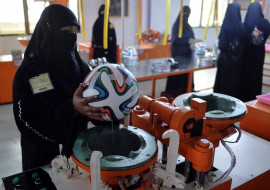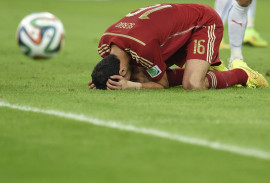
Pakistan had exported footballs called the Brazuca that would be used during the World Cup. It was one of Sialkot’s finest hours.
Sialkot has been precariously close to the Line of Control, which is an hour’s walk away from the city. Far away from the motorways, it cannot be used as a transit city. Its two access roads, clogged with heavy traffic, were never converted into dual carriageways until four years ago.
Never wallowing in its isolation, Sialkot acts more like West Berlin during the Cold War; an enclave of economic success surrounded by a dysfunctional East German state.
Sialkot exports goods worth $1.6 billion every year. This is an incredible $4,000 of export revenue per capita. If the rest of Pakistan did exactly what Sialkot does, our export earnings would have been $675 billion — 25 times more than the current level. That would have made Pakistan the world’s sixth largest exporting nation, just behind Japan.
The town’s economic miracle appears even more amazing when seen in the backdrop of its natural endowments — there are none except paddy fields. It still does not have a university or a professional college or even a decent polytechnic or vocational institute. Its international airport became operational in 2008 — the country’s only airport that has been built by private capital.
Economic planners and politicians usually begin with cries for good governance, education spending, infrastructure, public health, easy access to capital and affirmative actions for helping nascent industries. These economic managers would struggle to explain Sialkot. It remains an aberration. The town has clearly succeeded despite all odds.
In a nation with zero equestrian traditions apart from Shandur Polo festival, Sialkot manufactures and exports saddles and stirrups, reins and bridles; even giant nail cutters and nail jacks. The artisans and their trade died when automobile replaced horses, a century ago. Riding, racing and show jumping have since remained pursuits of the wealthy. Sialkot has kept this tradition alive. In this day and age, it manufactures and exports $200 million of equestrian equipment.
There are even more arcane items that seem improbable to conceive much less find an export market for. Think punching bags of all sizes — Sialkot is their largest producer. Cricket and hockey gear is ubiquitous and thus may not surprise us. It has been manufactured in Sialkot since pre-partition days. What is extraordinary is the sports gear for baseball and American football. These sports have never been played in our region but yet Sialkot produces top quality gear.
One may say that Sialkot has struggled with higher education. And yet it has more than a thousand manufacturing units (mostly home scale) that produce a range of surgical instruments. Manufacturing them was spurred by World War II when these were in great demand in Burma’s field hospitals. Since then, Sialkot has continued to excel. This unique industry earns another $300 million in exports.
Also improbable is the fact that the country’s largest leather tannery and leather garment units are in Sialkot. Leather tanning and leatherwear industries together with knitwear and sportswear bring another $500 million.
When it comes to footballs, no one in the world comes even close. Everyone from Adidas, Nike, Puma to Wilson has only Sialkot in their sights. It produced more than 42 million in the run up to the Fifa World Cup, fetching $300 million.
The closest to other towns that Sialkot could be compared to are the dozens of small towns of Tuscany, Lombardy, Veneto and Emilia-Romagna regions of Northern Italy. Such towns with their small family-owned manufacturing businesses have traditionally powered the Italian economy and introduced Italian workmanship to the world. Sialkot operates in a similar spirit. An entire family runs the business with some hired help. With each new generation, more business units are created.
A lesson for the rest
Every family knows everybody else’s rags to riches story in Sialkot. The pressure to innovate and succeed is immense. Role models are plenty. If anything, the quest to export is considered noble and bankruptcy its normal outcome. But no one’s ever been blamed for trying. What follow are risky ventures whose chutes are steep and predictable. And yet thousands of wannabes keep trying; where only dozens succeed. The latter power the $1.6 billion export juggernaut that Sialkot has become.
Sialkot teaches us about the absolute central role that entrepreneurship plays in transforming lives and generating wealth without government involvement. It teaches us despite without much technical education, determined entrepreneurs can master artisan crafts and produce unusual products.
Sialkot combines all these factors to produce great results. The town displays a mindset that is not afraid to dream and considers failure only an opportunity to learn and try again.
Sialkot does all of this brilliantly, leaving one wondering what if the rest of the country did what Sialkot does?
The WRITER IS AN ENTREPRENEUR WHO HAS WORKED IN BANGLADESH’S GARMENT SECTOR
Published in The Express Tribune, September 1st, 2014.
Like Business on Facebook, follow @TribuneBiz on Twitter to stay informed and join in the conversation.
COMMENTS (7)
Comments are moderated and generally will be posted if they are on-topic and not abusive.
For more information, please see our Comments FAQ






















1713904359-0/burn-(1)1713904359-0-270x192.webp)






1713853507-0/MalalaHilary-(2)1713853507-0-270x192.webp)







was wearing burka necessary? seriously ??
Very well written & very inspiring. Sad, public sector is sleeping. Keep up the good work brother.
We salute you Saquib Saeed for giving us this awe inspiring article on Sialkot. Really wish Imran Khan & Imran Qadir read it and go back home to transform Pakistan into worlds leading exporter of goods.
thumbs up.........an inspirational article for the entrepreneurs...
Wonderful article about my city, however I would point out that Sialkot's industry is dying due to chronic energy shortages. Furthermore, lack of qualified labor/engineers is also hampering profitability. I have seen with my own eyes over a thousand units close during the last decade and those that are operating are on the verge of collapse.
Well done Sialkot!
Very true. I work in medical field in US and have used the Surgical Instruments that are made in Sialkot, Pakistan. The small and medium size enterprises employ make up 75% of economy in developed economies of USA, Europe and Japan. The Large scale manufacturing employs less than 10% of their work force. Same can be done in Pakistan, Pakistan just needs to look within itself to find out it has got everything it takes to be a developed nation, without any assistance or foreign aid.